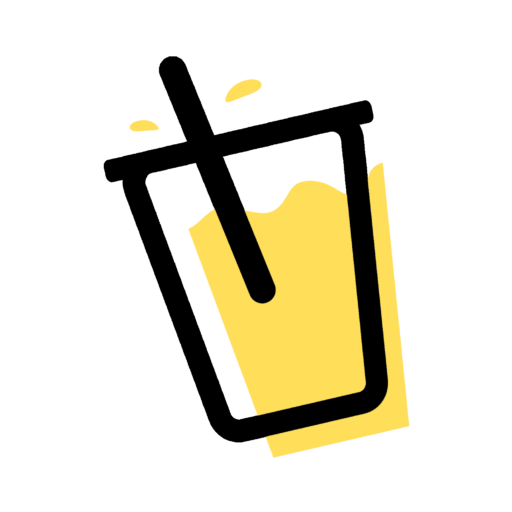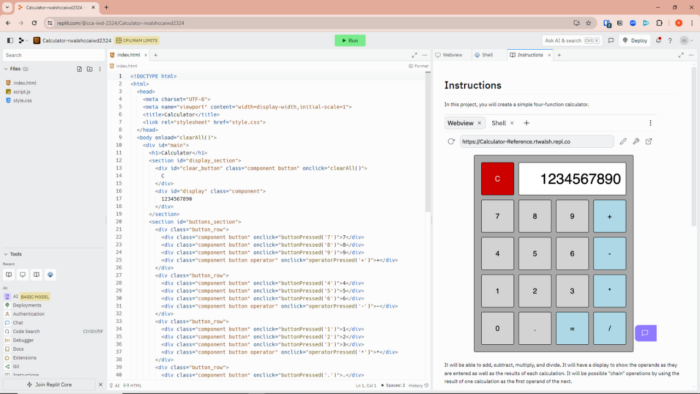Course Details:
- 1 live class per week
- 4 weeks
- Live Class Length: 55 minutes
- 18 seats per section
- Homework is assigned
- Teacher feedback offered on homework
- Materials
Students will need either an account at Replit.com (https://replit.com) or the ability to create a project directory and files on their own file system. If they choose to work locally, they will also need a suitable editor capable of loading and saving plain text files (e.g., files with no extra formatting). Visual Studio Code (https://code.visualstudio.com) is recommended.
Introduction to Web Development – HTML, CSS, and JavaScript – A Web-Based Calculator
Use HTML, CSS, and JavaScript to create a web-based calculator in this 4-week mini-course. Students will use HTML to define the overall layout, CSS to make it look like a real calculator, and JavaScript to make it dynamic and interactive.
Section Options / Enroll:
- Description
- Lesson Schedule
- Class Intro Video
- A Biblical Worldview
- The Lemons-Aid Way
- Teacher Bios
- Outschool
- Request a Section
- Reviews (0)
- Philosophy of Teaching: Science
Description
HTML, CSS, and JavaScript are the three coding languages that form the basis of every modern web page. While many web sites today are built using drag-and-drop tools that require little if any coding, the results are often not exactly what the web designer had in mind. With just a little background in HTML, CSS, and JavaScript, one is able to make adjustments to the layout and appearance of the page to bring it closer to the designer’s original vision.
Students who know HTML, CSS, and JavaScript are laying the foundation for a career in web application development. Front-end web developers use all three of these languages as part of their everyday work. Back-end web developers work extensively with JavaScript, but they, too, often need to embed HTML and CSS into the content the server delivers to the web browser when responding to a request. Finally, software testers who verify the behavior of web applications use HTML, CSS, and JavaScript to create thorough sets of automated test cases.
In this course, students will use HTML elements to create a four-function calculator capable of performing addition, subtraction, multiplication, and division. They will then use CSS to modify the way each element is rendered by the browser so that the page looks like a a real-life calculator. Finally, they will use JavaScript to provide the instructions that allow the calculator to perform the calculations. They will learn about program state and how much effort generally goes into error handling and prevention.
The course will meet virtually for approximately one hour weekly for four weeks. In each interactive session, the instructor will provide instruction, lead guided practice, and answer questions. Students will then be given an assignment to complete on their own to complete before the next session. Students can contact the instructor between sessions via email (or an equivalent medium), and the instructor will provide feedback and suggestions on the assignments.
Students who complete this course as well as
HTML and CSS Basics
HTML, CSS, and JavaScript – A Web-Based Calendar
Using Web Service APIs – Weather Report
are eligible for a one-semester credit for a course entitled “Introduction to Web Development.” It is recommended but not required for students to complete HTML and CSS Basics before taking this course.
Lesson Schedule
| Class 1 | Creating the HTML structure | In this lesson, students will create an HTML page to define the basic structure for the calculator. The page will not yet look like a calculator, but it will have placeholders for a display and the necessary buttons. |
| Class 2 | Styling the page to look like a calculator | In this lesson, students will define style rules and properties to make the HTML page look like a calendar. |
| Class 3 | Implementing the core functionality | In this lesson, students will write JavaScript code to “teach” the calculator how to perform the mathematical operations. They will learn about keeping track of the program’s state as the user goes through the steps for the various calculations. |
| Class 4 | Handling and preventing errors | In this lesson, students will identify and address ways the user might use the calculator that are other than what is expected and intended. They will learn that handling and preventing errors often requires more time and more code than implementing the “happy path” scenario. |
Class Introduction Video
Taught From a Christian Perspective
Coding & Tech:
The fact that humans have the knowledge and ingenuity to create something as complex as the Internet and the various languages and protocols that make it work is a testament to God’s role as the Creator. It is further proof that we were created in His image and given just a small fraction of His abilities to serve as stewards of His world.
All Classes:
Our mission is to equip learners’ minds and shepherd their hearts. We want them to have saving faith in our Lord Jesus Christ and then develop a biblical worldview. This means they view their world, themselves, and God in a way that aligns with what the Bible teaches. This brings great peace and understanding to the believer because we serve a good, sovereign God. This course is taught with these goals in mind. In class, we may pray, read scripture, and discuss how to view the content from a Christian perspective.
We have adopted The Master’s Seminary Doctrinal Statement.
The Lemons-Aid Way
Rich Content:
For over a century, progressive education reform has been “anti-content,” which means they de-emphasize rich content and focus instructional time on things such as self-esteem and “skills” they hope will benefit a learner in the future. This is why American kids do so poorly in testing compared to nations with content-rich curricula. We want our learners to increase in knowledge and grow in wisdom, which our content-area experts foster while teaching.
The Lemons-Aid Team
Lemons-Aid teachers have a few things in common.
❤️ They love their students and value each of their unique strengths and personalities that make our classes special. Our classes can be described as fun, personal, academic, challenging, and supportive.
🤩 We work to keep learners engaged, so there is always a degree of student accountability for their attention and focus, whether that be through asking them direct questions or by using the chatbox.
💭 We know all kids can learn, but sometimes things are hard! To support students, we teach them how to develop effective thinking and learning habits that will bring them success in class and in life.
🌟 Building relationships with students so they know we care about them helps us balance the high expectations we have for them regarding their effort, work quality, and behavior. Our students are encouraged, cared for, and they achieve!
Learn more about Mr. Walsh!
Christian Teachers on Outschool
This course is not offered on Outschool.
Request a New Section
Want to see this class offered at another time? Send a request, and we’ll see what we can do!
coming soon





Reviews
There are no reviews yet.